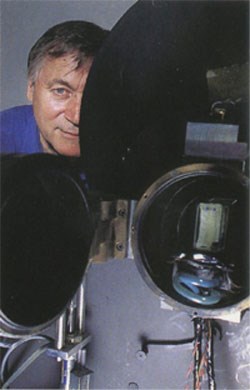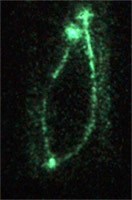The light of all life
The struggle of Fritz-Albert Popp
The German biophysicist Fritz-Albert Popp has established the existence of light in living organisms. The presence of these biophotons is undeniable. Experts are fighting about the origin of the light and about its significance.
Originally, Fritz-Albert Popp, born in 1938, wanted to become a philosopher. "Then my physics teacher persuaded me to study physics." But he preserved his penchant for unusual thinking though it exposed him to a life-long struggle for his reputation in academia. This despite the fact that, three decades ago, he made a discovery which he seriously thought could bring him a Nobel Prize in physics: he had discovered the existence of a weak light in living cells. It shines merely at a rate of a few quantas per second per square centimeter, equivalent to the light of a candle seen from a distance of 20 kilometers.
The existence of these biophotons has meanwhile become undisputed. Still, Popp received no Nobel Prize for his pains. Instead, his theories have been attacked as "esoterism," and "nonsense and poppycock." Fritz Schäfer from the Max-Planck Institute for biophysical chemistry in Goettingen admits, though, "that the ultra-weak radiance of cells is a generally accepted fact," and "that the origin of this radiance has not been ascertained until now," although he considers the theses of Popp "to have been clearly disproven."
But Herbert Klima, of the Atomic Institute of the University of Austria in Vienna, concedes that Popp, the "pioneer of research in biophotons," has delivered "three decades of serious scientific work." Udo Unrau, who was until a few years ago the academic director of the Institute for Highfrequency Technique of the Technical University at Braunschweig, describes Popp as "a highly competent scientist, who has trod on new ground."
How is it possible that a revolutionary researcher can be mocked by some of his peers as a charlatan, and celebrated by others as a visionary? It may be because Popp has chosen as his subject of study one on which modern natural scientists have long broken their teeth: the phenomenon of life itself. Life is something like a second Big Bang for scientists. In the case of the Big Bang, astrophycists are able to approach it through calculations as close as to its very first few hundreds of a second - yet the nature of the Big Bang itself remains obstinately hidden from them. Likewise, the phenomenon of life can only be circled and neared.
In 1944, quantum-physicist Erwin Schrödinger smuggled by means of an opuscule entitled "What is life?" the idea of information into biology, and this would shape the thinking of F.-A. Popp. In the 1970s, at the University of Marburg, he studied the photo-repair processes of living cells. In 1975, he succeeded in advancing the experimental proof of the existence of biophotons. Every living substance radiates a weak light in a wavelength ranging between 200 and 800 nanometers.
His doctoral student, Bernhard Ruth, had placed germs of cucumbers and potatoes, then, later, animal cells in a so-called photon-multiplier. At every test, the apparatus registered light emissions which became weaker with the passage of time. Tests with living and dead cells showed that the light emission decreases slower in the case of living cells. Popp concluded: the biophotons are created by electrons excited by sunlight. When the electrons then decay from their higher energy level, they emit light. For instance, in the case of a leaf which has been plucked for some time, the decreasing curve is more abrupt than in the case of a freshly plucked leaf, which brings Popp to conjecture that in the latter case, the electrons are not acting independently from one another. The electrons are, so to speak, informed about each other. The light is then coherent, as in the case of a laser.
But what function does this light fulfill inside the cells? One remark of Schroedinger put Popp on his track: "In the case of higher animals," wrote Schroedinger, "we know the type of order of which they feed themselves; it is the orderly state of matter in the compounds which serve them as nourishment." And, especially: "Plants, it goes without saying, possess their most important store of ‘negative entropy' in the form of sunlight." Popp has developed this thought further. Sunlight is an elemental source of nourishment for most living beings. From it, too, we humans draw at the cellular level energy and organizing signals. According to Popp, food is nothing else than light information. To put it briefly, we humans are "light-suckers."
It is this idea of the organizing function of light which angers many of Popp's scientist colleagues. For conventional biochemistry knows nothing of coherent states inside the cell, as biochemist Heiko Fickert from the University of Hamburg confirms: "Molecules inside a cell know certainly nothing about the other molecules." And this is how it happens that F.-A. Popp is not at the head of a leading university research institute, but leads a privately financed research laboratory which is housed in a barack near Neuss, on the banks of the Rhine opposite Düsseldorf, on the compound of a former NATO base, which a generous patron of the arts has transformed into a free work space for artists.
The ever a bit disheveled hair of F.A. Popp and his three-day old beard reveal how deeply he is absorbed in his work. In his International Institute for Biophysik (IIB) his little daughter Iris saunters among the measuring instruments and bundles of cables, while his companion Sophie assits in the work at the Institute. Popp likes to take visitors into a darkened room. There, he deposits a freshly cut branch of pine, a tomato or a hen's egg in the dark container of a photon-multiplier. A highly sensitive camera feels over the test material. On the monitor, the object then appears with green shining countours.
Popp has had cucumber sprouts of different qualities broken down by digestive enzymes and during the process measured the amount of light emitted: "One obtains a series, which corresponds to a quality-decrease through alteration." He established that the eggs of free range hens show a more intense radiance than those from laying batteries. Yet it is not only the amount of light, "but also the coherence of light which defines the quality of foodstuffs." He has tested over 2000 food products, proving that the light diminishes as plants decay or are digested. The measurement of light, according to Popp, delivers information where conventional analysis fails.
Decades of fighting for his ideas have worn him down. "I have the right to defend myself, don't I?" he says a little subdued, after delivering himself of a slew of abuse against the "predator attitudes and the diffamation tactics" of many of his colleagues. Popp was already known to be combative when he was "an épée fencer during his studies at Würzburg," says Herbert Klima in Vienna and opines that "this combative spirit has not particularly helped his scientific recognition."
Already in possession of a doctorate, Popp became an academic outsider as early as in 1972 when, after his post-doctoral "habilitation" he was "unanimously elevated to the dignity of ‘Professor'" by the Marburg University Senate, yet he garnered only a temporary employment as an instructor as a result. Popp remembers that his dean at the time, Heinrich Oepen, had informed the minister of cults of Hessen that "he had expert opinions at his disposal which made it appear well advisable to have him [Popp] committed to an insane asylum."
In 1980, Popp was dismissed from the University of Marburg. He worked for a short time as research director in a small pharmaceuticals company, then joined in 1983 the research team for cell-biology of Walter Nagl, a disciple of Konrad Lorenz at the University of Kaiserslautern, and in 1986 moved in with the neighboring center for technology. There, he created patents for the applications of bio-photonics: for instance, for the quality analysis of food-products, for use in medicine, and for the verification of bacterial contamination.
He was finally called to teach abroad: at the Indian North Hill University, at the University of Harbin in China, at Princeton University and at Temple University in Philadelphia. In 1998, Popp founded his IIB with 20 collaborators, to which meanwhile scientists from 14 universities and research institutes from all over the world have associated themselves. It is financed through research contracts with the German government, as well as with companies like Nestlé, Bahlsen, Beiersdorf, Kraft Foods and Henkel.
In the end, biophotons may well be a phenomenon of quantum physics. Many researchers in the subatomic sphere suspect that our whole material universe may be founded on information processes. The Viennese quantum physicist Anton Zeilinger, who was the first to achieve the experimental teleportation of light particles, admits: "I myself cannot really picture in my own mind what might be going on during these processes which take place outside of time and space." Still, one might "consider light particles as being pure information."
Popp introduced the concept of information into molecular biology and in so doing, put established biochemistry on its head. According to conventional views, it is randomness that rules inside the cells: "Processes are regulated inside the cell, but there exists no plan there," explains Heiko Fickert from the University of Hamburg. The organism is considered to be a swarming chaos of molecules where chance alone decides if, when and where chemical reactions take place.
Popp considers this view as absurd. In an unorganized chaos no meaningful cellular event could happen. Popp has established that the light in our cells does not behave in any way that is chaotic or random, but that to the contrary it presents astounding coherence. The photons, which according to quantum mechanics are all at once particles and waves, display during the measuring phase a stable superposition, called interference. They relate with each other, so to speak, and constitute, according to F. A. Popp, a coherent electromagnetic field, in which information is exchanged. The biophysicist believes that by the means of biophotons, cells communicate with each other inside the organism.
The question about the origin of the biolight remains unanswered. Popp points at DNA as source and storage medium: "This has to do with the extremely high density of information in DNA." Popp sees in his information-theoretical perspective a change in paradigm. "It is possible that matter is by no means a random heap of molecules deprived of relations with each other, but much rather a complex organization of electromagnetic oscillations," he speculates. This is the point at which the physicist leaves for good the experimental limits of the natural sciences and becomes a philosopher again.
Even to friends of the biophoton theory it is clear that "there are still many unanswered questions," admits a medical physicist from Lübeck, Lebrecht von Klitzing. "Let's take as an example the onset of shock: the heart begins to run amok, then a coordinated interplay of the individual cells sets in within milliseconds. No doubt that there must exist an organization there," says von Klitzing and guesses that the biophotons "may well have something to do with it." Von Klitzing takes for certain "that everything that is submitted to biological regulation must be synchronized and directed. But how all this hangs together, nobody knows."
Popp agrees that his conception of light is still at its beginnings. "We know that this luminescence exists but we cannot decipher it yet." And he is quite aware that any natural scientist seeking for meaning arouses suspicion: "This is one point where my theories offer themselves to attack." But when he lets go of the physicist and reverts to being a philosopher, something like peace takes possession of him again.
Holger Fuss, translated from the German by Ami de Grazia
published in Der Spiegel, 2005.

Fritz-Albert Popp
Origins of Biophotonics
Read also: Alfred de Grazia: The System of Reception of Science

biophotonic picture of algae

